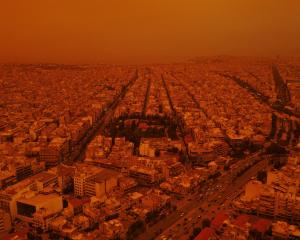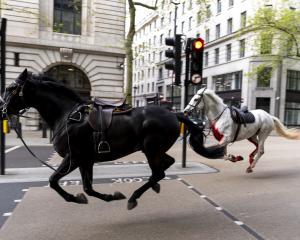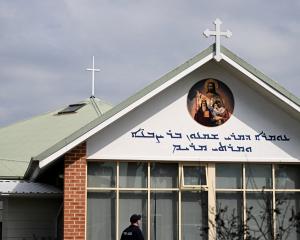The stone walls are pockmarked with bullet holes, whole houses have fallen after air strikes, and small wooden doors decorated with metal filigree are cracked from explosions.
For a month, rebels armed with assault rifles and grenades have battled President Bashar al-Assad's army along Aleppo's cobbled streets. Troops have used tanks, helicopters and jets to shoot, blast and bomb their positions.
"Every day there is fighting in Aleppo's Old City. Yesterday a jet bombed twice. The helicopters fire on us and there are mortar bombs every day," said rebel fighter Ahmed Hanesh, a 19-year-old student from the old district of Jedeide, standing guard at the edge of the Old City.
Even before the fighting, time had forced houses made of stone and wooden beams to lean under their own weight and Aleppo's ancient mosques are crumbling. But the new scars are prominent.
"How can we protect the old houses? We have to protect ourselves first," said Hanesh, his green head band and ammunition jacket popular attire for rebels who see themselves as the protectors of civilians from Assad's feared militia, the shabbiha.
Further into the Old City, the streets taper. Families with young children walk in the opposition direction with their possessions - refugees fleeing pitched battles.
A teenage boy holding a mattress over his head warns that further in it is not safe: "There is destruction in there," he says, before scurrying after his mother.
Where tourists once marveled at Aleppo's preserved madrassas and ancient markets - imagining themselves in an Arabian Nights fantasy - now fighters stand at every corner with their weapons placed on sandbag barriers. The tourist shops are shuttered, their famed green olive soap locked up; an industry ruined.
The aroma of home-made perfume and spice markets has been replaced with the smell of stone dust, chipped out into the air by shrapnel and bullets.
Rebels and government troops here fight street by street. Enemies position themselves only metres away from each other as the ziz-zag alleyways grant some protection from a direct line of fire. They know Aleppo's stone buildings will take the blows.
Aleppo's Old City is one of several locations in Syria declared world heritage sites by UNESCO, the United Nations cultural agency, which are now at risk from the fighting.
"It's a catastrophe. Aleppo is thought to be one of the oldest towns in the world and a crossroads for some of the region's most important historical developmentS," a UNESCO representative told Reuters in Paris.
"It's extremely important symbolically and we're really very worried."
UNESCO believes five of Syria's six heritage sites - which also include the ancient desert city of Palmyra, the Crac des Chevaliers fortress, and parts of old Damascus - have been affected.
Crac des Chevaliers, an almost intact crusader castle perched on a mountain in central Homs province, repelled waves of medieval offensives but was no match for modern explosives. Video footage has shown what appears to be damage from mortar or artillery to its 13th century battlements.
Worried by the risk of looting at archaelogical sites, UNESCO has contacted Interpol and neighbouring countries to halt any smuggling of artefacts.
"Of course the main priority is protecting civilians, but Syria's heritage is also extremely important, because it's part of the country's identity," the UNESCO representative said.
"Past experience with Iraq for example has shown just how much damage can be caused to a peoples' identity," he said, citing the looting of the Baghdad antiquities museum after the 2003 U.S. invasion to overthrow Saddam Hussein.
Baghdad's museum was ransacked within days of Saddam's overthrow, an early sign of the chaos which eventually plunged Iraq into sectarian war.
In Aleppo, rebels now claim control of roughly half of the Old City, mostly to the east. Government forces and shabbiha control the main souk, the main Ummayad mosque and Aleppo's biggest prize: the citadel.
From a safe distance, the half-kilometre-wide medieval fortress can be seen rising above the city. Its huge wooden gates were broken into by shabbiha and now its immediate surroundings are a no-go area.
Residents say snipers have positioned themselves in the thin stone windows, first carved out for archers. Today's snipers are precise and they shoot on sight, residents say.
And civil war between a president who comes from a minority Alawite offshoot of Shi'ite Islam against a largely Sunni Muslim majority has broken the delicate sectarian balance of the Old City, where religious groups lived side by side for centuries.
Saeed Ali, another young rebel in Jedeide, says that residents of Aleppo's Christian quarter have sided with Assad. "All the Christians volunteer to fire Kalashnikovs against us," he said, kicking spent bullet cases which lie idle on the road.
"The Old City's Kurds are with Assad, too. Even the women fight," he said.
Sunni residents say their own sect's treasures are being deliberately targeted. Ahmed Ibrahim, an electrician who also works to maintain one of Aleppo's 14th Century Mamluk mosques, says Assad stirred up sectarian tensions to promote the idea that he is fighting extremist terrorists.
Ibrahim said that over the weekend a jet dropped a bomb a couple metres from the main minaret. The limestone walls held strong but the prayer hall was damaged. The cool interior, sheltered from the August sun by its domed roof, was full of broken glass and debris.
Further down the road, another mosque was not so lucky. One bomb missed, leaving a 3-metre deep crater in the street. The next one hit the mosque, causing a bus to flip over, and the cemetery to crack open, its marble tombstones bowing over from the shockwave.
As Ibrahim spoke a government fighter jet flew overhead at 300 feet, firing on a nearby district. The Old City dweller took refuge in a nearby alcove.
"Jews, Christians and Muslims know that God is watching them," said Ibrahim, a pious man who keeps a well-cut beard and wears long robes. "Assad has forgotten."












